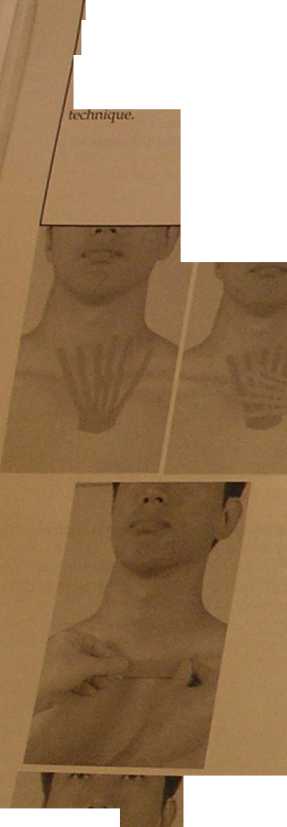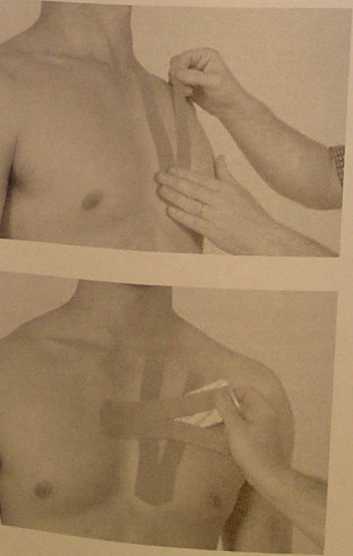P5140040
m -

MM
Stemoclavicular Joint Sprainj
The stemoda\icular joint is an uncommon injury, which is generally ca f through the shoulder to the davicle. The joint is moveablę, and is the prjJJUSed. by a fQ during the initiation of shoulder abduction to90degrees. Ithas a history ajjJCe_
£n« <l°F' lsp4e>W.^»
c°rh
USe°fth
The Kinesio Taping Method assists by redudng edema, and pain withth
ł0j,
ii
Application oftheZ^T^--■---
to edema resuh;^Pta hc
stemoclavicular (SC) i^8 fro,» a
ftnpswiUbeappned ^ Txvq
fyrnphaticcorrective
Strip one beeinc ałni9ue e revle. c°rh.
•ns
%
The I^TpssZlt ToS**' 1 Wi i
1 H
APPUcationofaSpacecnt_ complete review see snl^on
wchlfaJsio^striif^
StnPP'aWd H oveftJ;P^“’ SM
e5CJQirife terof(^
ro^ZttmOVe 8 B p i
bases o/ the Kinesio IS*17 Slte' % dowT°n %
RePeaf iHUH i i
d°~ B i
Scoliosis
Scoliosis is a la terał curvature of the spine, most commonly in the thoracic region, with an associated rotadon of the vertebral bodłeś. The condition can be functional or structural in cause. A unequal leg lengfh, and unequal muscle deve!opment are examples of a functional cause. Structural causes may result from a bony defect in the spine.
The scoliosis technique demonstrated should only be used as an example. The practitioner following theirevaluadon wili need to determine the location of the curvature and degree and direction of rotadon to the spine.
The Kinesio taping method will assist by either increasing or decreasing muscle tension, and create tension through the skin to facilitate an "unwinding" of the spinał rotadon.
Application of a mechanical correcdon technique to provide a sdmuli in which the body will adjust to increased tension in the skin, with tension on the tails. For review see mechan ical correcdon tech-nique.
For the anterior superior region begin by placing the base of the Kinesio Y strip, of approximately 6-8 inches, two inches below the area to be treated, with no tension. With one hand, hołd the base to ensure no tension is added.

Have the patient move into back extension with rotation in the opposite direction of desired correc-tion. Apply tension to the tails of the Kinesio Y strip, the "recoil" action of the tails will provide the stimulus to the skin.
Apply the tip of the taił with no tension. Prior to any further patient movement initiate glue activa-tion.
Application of a fascia correction technique to provide a deeper stimuli to reduce tension within the layers of the tissue, with tension on the base. For review see fascia correction techniąue.
Begin by placing the base of the Kinesio Y strip, of approximately 6-8 inches, two inches medially to the area to be treated, with no tension. With one hand, hołd the base to ensure no tension is added.
37
Wyszukiwarka
Podobne podstrony:
QUICK LESSON OF HISTORY • THE FIRST COMPUTER PROGRAM IS GENERALLY DATED TO 18
P5140053 El bo w Hyperextension f The elków is .1 relatieely stable joint which ma
P5140043 Costochondral Separation or Sprain A separation or sprain to the juncfion of the castocarłi
P5140084 Sciatica is an inflammation to the sciatic nerve which is generally associated with Iow bac
P5140009 patient, place the base in as close an ana-tomical position as possible. Make surę to rub t
P5140010 "Fan" Strip Application The Fan Strip is applied with the patient in a stretched
P5140025 Cervical Spondylitis Cenical spondylitis is an inflammation of one or morę vertebrae in the
P5140050 Valgus Laxiły of the Elbow A chronic valgus larity of the elbow may develop from repetitive
P5140051 Yalgus Laxity of the Elbow Combination •nic valgus laxity of the elbow may develop from rep
P5140052 Bursitis of the Elbow Theolecranon bursa is the most commonly injured bursa of the elh okcr
P5140057 Medial Epicondylitis of the Elbow Medial epicondylitis results from repetitive forceful f!e
P5140058 W *• —- I----------Ul to ; for the area to be treated. In the center of the Kinesio Sfc Hav
P5140062 Lymphedema ol Lymphedema of the upper extremity is the result of edema Ihat 9 " tion.
P5140063 lateral epiconayic jH — , the proximal phalawc, and back to the humerus on the dors.il sidc
P5140064 Wrist Sprain ~ Trifibrocartilage (TFC) Vr»sł sprain* ttfe a common acute and chronic injury
P5140066 Option 2; Tape through the palm. Place the hand as described in option by placing anchors 2
f10 11 Ą* Untitled - Map Demo File Help Key 3 is associated with the value Three Key 4 is asso
f11 9 Label Tester! HU Hi, this is the versatile JifLabel! It is a multi-line label that was ve
Future Simple repeated actions m the futurę [1 consequence 1 1 unplanned /
więcej podobnych podstron